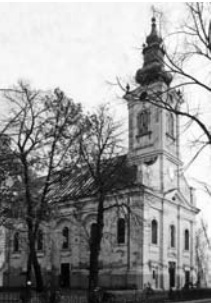According to one record of the 1762 Segedin Franciscan priest in Mol and Petrov village, there could have been very few Catholics among the Serbs. Serbs already had a church of bricks and 1,118 believers. They also had four pops who had 25 members of their families. ” It is said that there is no Catholic church or chapel in the city, and the dead are buried in Ada.
The existence of the first sanctuary in Mol indicates the established and enclosed wooden cross, which the Serbs built in 1824, when a newly built church was consecrated, probably in the former center of the town, on the site of the old church altar. The foundations of today’s church, which was built of hard materials, were laid in 1808, and due to lack of funds, construction was in stages. With the advocacy of Vasili Kovačić, protopreservers of Segedin and the mothers’ parish, in 1824, the church was finished and dedicated to St. Savi, and finally it was refreshed only after painting the interior, in 1862. The church is basically a one-nave building with a semicircular apse in the east and a bell tower that rises on the front. It was built with clear and certain classicistic features as well as a composite ornament that corresponds to the time of the creation of the building itself. In the realization of certain architectural and decorative elements of the interior, it has similarities with the Orthodox church in Kulpin.
The western facade is basically somewhat wider than the base of the naos and is richly processed. Four pilasters with profiled capitals break down the wall canvas, and two central supports in the roof zone of a larger profiled tympanon with a centrally positioned okulus. The lateral two semicircular niches were finished with fins that were painted. In the left niche is shown the performance of St. Sava, and on the right is Jesus Christ. Wall paintings have in the meantime been overdone and significantly damaged. On the side facades are shallow drains – singers who have a niche shape on the inside. The length of the aperture between the pilasters is cropped with an arch or a conch.
All windows are arched, and the whole classicist decorative concept is reduced to a plastic geometric decoration that follows the openings along the entire wall canvas. The bell-tower is flanked by mildly curved calcans ending with volumes, and in the lower part relying on a four-pound pylon on which are placed acrobatics in the form of tin vases.
The inner space of the church is divided into the area of priory, naos and altar. The side walls are completely flat and smooth, with an imitation of architectural plastic in the shape of the capitals. Between the arches are spherical vaults with reduced geometric fields, colored with the dominant ultramarine backing, while the other wall surfaces are derived in “marbling” hues.
Above the porch is a raised chorus separated from the nave by a high wall broken with three arched holes placed on the same axis. The parapet of the chorus on all three floor openings is made by plastic processing of surfaces in the form of a series of oval, upright rings, one of which is a bell-shaped flower, placed in a pair up and down. The cast iron barrier, placed above this plastic cabinet, dates back to modern times.
The preaching hall is a significant work of applied art of the XIX century and enables dating and stylistic analogy with other similar objects of artistic crafts in Vojvodina at the time of its creation. According to the record, in the lower part on the convex surface, we find out that she gave the church to the church in 1846. Jakov Milic, “the resident Martonoski born in 1790”.
Iconostasis is conceived in the spirit of classicism, respecting the strict regularity of the basic lines that divide the entire composition vertically and horizontal in several zones. An unusual phenomenon in the construction of the frame of icons on the mole iconostasis are frames with a broken Gothic arch, which marks the very early notion of neo-geotics, in the Orthodox temple whose tradition has this stylistic element completely gone.
At the iconostasis are the works of three masters: Arsenije Teodorović, Nikola Aleksić and Novak Radonić. According to written sources, the iconostasis in Mol was first painted by Ars Teodorovic, but Nikola Aleksic restored it and painted several icons on it during his studies in Vienna (1831/32) occasionally coming to Mol. His contribution is in the final formulation of the classicist concept, which Teodorovic, educated at the Vienna Academy just at the time of accepting new Classicist attitudes, just hinted. Novak Radonić, although more famous as a portraitist, on religious performances, painting only central doors and icons on the trunks in a mosque church, in 1854 points to the outstanding painter of a full romantic charge.
The wall painting on the arch above the soley is the work of Nikola Aleksic. In the middle is the performance of the Holy Trinity, side by side an angel in a symmetrical position. The Virgin’s throne was donated to the temple by the Radonić family, as it is written at the bottom of the icon, and the NR 1854 sign printed on the trunk of the head on which the Virgin sits, indicates that it is Novak Radonić’s work.
In the Archbishop’s Throne is the icon of St. Nicholas in the Episcopal Ornate, the work of the second half of the 18th century.
SERBIAN ORTHODOX CHURCH OF ST. SAVA


0 comments on “SERBIAN ORTHODOX CHURCH OF ST. SAVA”